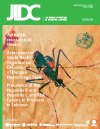Prevalence of antibodies to human immunodeficiency virus (HIV), hepatitis B and hepatitis C and risk factors in prisoners in Lebanon
DOI:
https://doi.org/10.3855/jidc.517Keywords:
HIV, HBV, HCV, Risk factors, Prisoners, LebanonAbstract
Background: People admitted to correctional facilities often have a history of risky behaviours which frequently lead to transmission of blood-borne viruses, such as human immunodeficiency virus (HIV), hepatitis B virus (HBV) and hepatitis C virus (HCV). Our aim was to determine the prevalence of HIV, HBV and HCV infections among prisoners in Lebanon.
Methodology: Conducted between August 2007 and February 2008 in Roumieh Prison, Lebanon, the study included a total of 580 male prisoners aged 16 and above who were randomly selected from four prison blocks. Peripheral blood was collected by a finger prick, blotted onto high-quality filter paper, dried and later eluted to be tested for markers of HIV, HBV and HCV infections.
Results: A significantly higher seroprevalence of HBV (2.4%) and HCV (3.4%) was found among prisoners compared to the seroprevalence of these virus infections reported in the general Lebanese population (< 1% for HBV and HCV). Only one of the 580 prisoners tested (0.17%) was confirmed as anti-HIV-positive. The majority (89%) of anti-HCV-positive prisoners had a history of previous imprisonment and were injecting drug users (IDUs). Tattooing was also associated with HCV transmission: all nine anti-HCV-positive prisoners had tattoos compared to only 60% who were anti-HCV-negative. Only HCV genotypes 1 and 3 were detected.
Conclusions: We provide evidence for an outbreak of HCV and HBV occurring in Roumieh prison. In addition to vaccinating prisoners against HBV, collaborations should develop between the prison's administration, academic institutions, and community-based organizations to provide HCV prevention services within the prisons.
Downloads
Published
How to Cite
Issue
Section
License
Authors who publish with this journal agree to the following terms:
- Authors retain copyright and grant the journal right of first publication with the work simultaneously licensed under a Creative Commons Attribution License that allows others to share the work with an acknowledgement of the work's authorship and initial publication in this journal.
- Authors are able to enter into separate, additional contractual arrangements for the non-exclusive distribution of the journal's published version of the work (e.g., post it to an institutional repository or publish it in a book), with an acknowledgement of its initial publication in this journal.
- Authors are permitted and encouraged to post their work online (e.g., in institutional repositories or on their website) prior to and during the submission process, as it can lead to productive exchanges, as well as earlier and greater citation of published work (See The Effect of Open Access).








